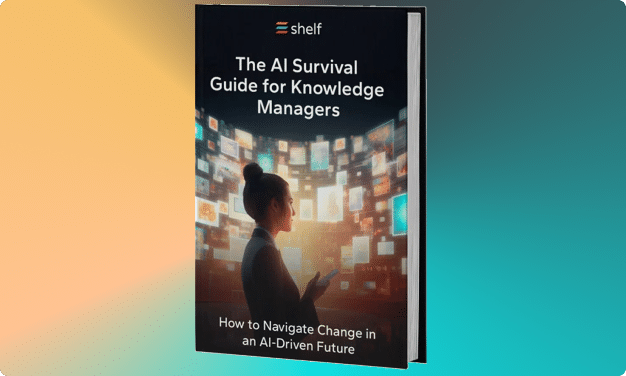There is more content, on more platforms, in more locations, than at any time in the past. If you’ve managed knowledge in any context, you know how time consuming it can be to find what you need, especially if knowledge is siloed in multiple locations (as it is for many companies). You know how important it is to implement knowledge management best practice examples to better manage that content.
Despite this information challenge, time is valuable. Your employees need knowledge in the right place, at the right time—including agents in your contact center. What matters most is how reliable, relevant, and fast your knowledge can be accessed by people who need it most.
There is no single solution to solve every knowledge management problem overnight, but there are some general knowledge management best practices you should follow.
In this post, you will learn a few knowledge management fundamentals to help your support time find what they need…a lot faster.
Knowledge Management Best Practice 1
Centralize Key Knowledge to a Single Location
Content should always be quick to access, and easy to find for your support agents; if agents don’t know where to look…this poses a huge problem for many customer interactions.
You should always centralize important and often-accessed content to a single location, so agents don’t waste time trying to locate documents elsewhere.
If you centralize all your content to a central location, you make it easy for agents to access answers, and easier for admins to maintain. Knowledge managers and subject matter experts that maintain content shouldn’t duplicate effort across multiple platforms!
To learn more about getting rid of knowledge silos, check out our post on knowledge management mistakes; silos are very common and a common cause of inefficiency for agents.
Knowledge Management Best Practice 2
Design for Both Search & Browse Behavior
When users need to locate content, their approach can be broadly classified into two seeking behaviors: browse and search.
Browse behavior
Agents often browse, they traverse a taxonomy incrementally with a rough idea of where they need to go to find what they need. A clearly articulated information architecture (for example: folder names) guides them.
Sometimes employees or agents can find what they need by browsing, especially if they don’t know what keywords to use. Search is incredibly powerful, but you should still organize your KM solution in a way that makes it intuitive to browse for knowledge.
Search behavior
Since people often know what they need before they begin a search, your KM platform’s search capability matters. If users can’t find what they need after typing a few keywords, it’s time to re-evaluate your KM vendor.
Shelf’s pinpoint search searches for keywords within documents in your library (as opposed to titles), and gives users the same smooth search experience they are used to in a web browser.
Since time matters in the contact center, agents shouldn’t need to use more than a few words or letters to quickly find a document or answer.
Knowledge Management Best Practice 3
Create a Standard Taxonomy
The way you design your knowledge taxonomy matters a lot, especially for instances when agents must browse for information. Before you launch or redesign your taxonomy, get buy-in from contact center agents and executives.
Here are a few good topics for discussion:
- Folder names
- File naming conventions
- How to use tags
- How to create titles
The taxonomy of your KM system should use the same lexicon as the environment in which it operates. Simply put, the words used in a taxonomy should be the same words your company uses, and make sense to most people.
Team members shouldn’t question the language used when they browse for something; by aligning on a taxonomy, you increase agent efficiency and employee efficiency because things are easier to find.
Knowledge Management Best Practice 4
Use Tags and Categories to Improve Findability for Agents
Tags make it easier for searchers and browsers; they provide context to narrow down search results. Agents who browse for content often have context to know where to start, but agents who start with a search often must weed through seemingly similar search results.
As a pre-search filter or a post-search refinement, tags aid seekers in determining the “aboutness” of a search result. Encourage employees to add tags any time they add new content, because tags improve findability and can help identify areas where content is needed.
Tags also help organize content that doesn’t fit nicely in a category. Check out our post, Why Knowledge Management Must Include Tags for a detailed explanation.
Knowledge categories can help your support team
Categories are the highest level indicators of content in a knowledge management solution, typically tied closely to the central needs or functions of your company.
You can use categories to define your company’s core offerings, or use categories to group content by For agents in the contact center, folder categories make it faster to find information related to seasonal discounts, for example.
Search is getting smarter and smarter, but categories are helpful when agents don’t know what to search for.
Knowledge Management Best Practice 5
Establish a Consistent Review Process
Agents can only be effective if knowledge they use is usable and can be found easily. You need a regular review cycle, regular folder maintenance, spot checks on content, tag audits, and category reviews to keep knowledge up-to-date and accurate. That’s a lot of work!
Luckily, automation can help identify out of date content and provide insights automatically using AI—assuming you use a modern knowledge management platform.
You should also have a mechanism to collect feedback from agents on the front lines if they notice content needs updating. A content maintenance process that involves key stakeholders is just as (if not more) important than auditing your category or tag structure.
Knowledge Management Best Practice 6
Use a Modern Knowledge Management Platform
Technology can help your contact center in more ways than one, but you need the right knowledge management platform to make it work. A solution that uses AI, one that provides the contact center integrations you need out of the box.
A simple knowledge base (or legacy knowledge solution) that’s difficult to use, integrate, and maintain won’t help agents…it will only slow them down.
Here are 5 things to look for in a KM platform that can benefit your contact center environment:
- Integrations with CCaaS platforms to natively to surface answers faster
- Ability for agents to easily leave comments on knowledge base content that needs updating
- Insight and analytics to contact center managers—particularly for content not being used, or content that receives poor feedback from customers or agents
- Notifications to remind agents when critical policies or important content has been updated
- Integrations with IVR systems to surface better answers, eliminating this common knowledge silo.
As you sell a knowledge management initiative up the ladder and to other stakeholders, the benefits of this solution should extend to your contact center—like surfacing answers quickly.
Many Shelf customers reduce handle times, escalations, and boost first contact resolution metrics once a better knowledge solution is in place.
Ready to explore a better knowledge solution for content center will benefit from?
Check out our Knowledge Management Buyer’s Guide to go in depth on what to look for in a KM platform.
This post was originally published on June 14, 2021 and updated on June 17, 2022.




